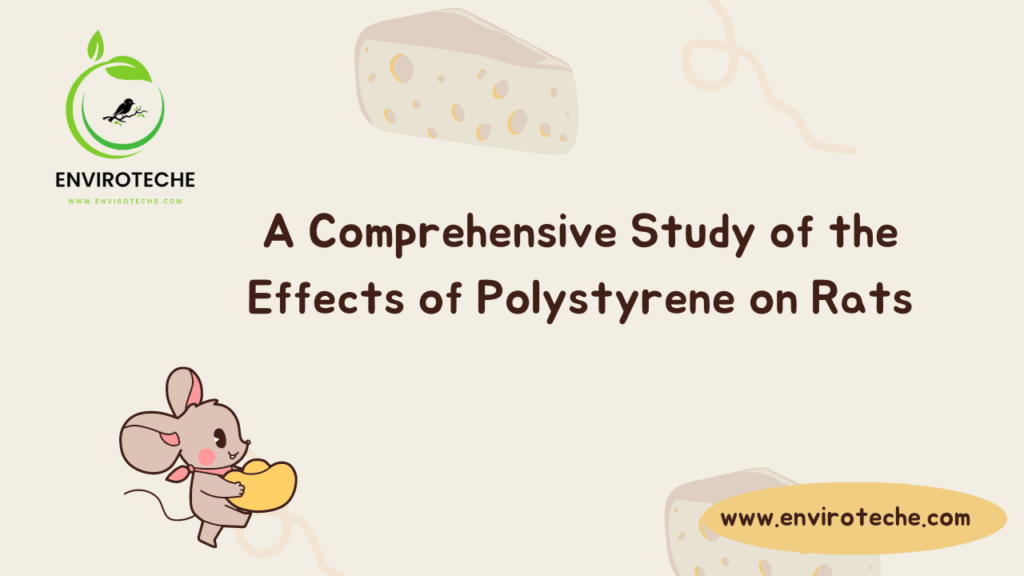
Nimra Ather1, Muhammad Qasim2
Department of Zoology, University of Agriculture Faisalabad1
Department of Environmental Sciences, Government College University Faisalabad2
Abstract:
A common synthetic polymer used in a variety of consumer goods, including insulation, packaging, and food containers, is polystyrene. Despite being widely used, questions have been raised about PS possible negative effects on human health, especially when it comes to exposure in animal models. The effects of polystyrene on rats are succinctly summarized in this blog post.
Introduction:
A common synthetic polymer found in many consumer goods, including insulation, disposable utensils, and packaging, is polystyrene. The possible negative consequences of PS on the environment and human health have been a source of concern. Rats are frequently employed as model organisms in scientific studies, thus in this blog, we will examine the specific impacts of PS on them.
Inhalation of Polystyrene Particles:
According to studies, rats exposed to polystyrene particles in the air may have respiratory problems. PS microplastics can cause lung inflammation, oxidative stress, and lung tissue architectural alteration when inhaled. Long-term exposure may even cause rats to acquire respiratory conditions like chronic obstructive pulmonary disease (COPD) and symptoms of asthma.
Oral Exposure to Polystyrene:
Rats ingested with polystyrene have shown a variety of health problems. Because PS is difficult for the body to digest or metabolize, it builds up in the digestive system. This buildup has the potential to result in physical obstructions, which could harm the gut lining and create gastrointestinal obstructions. Additionally, consuming PS microplastics has been linked to changes in the composition of the gut microbiota, which can be harmful to the rat’s general health.
Endocrine Disruption:
Styrene, which is known to have endocrine-disrupting effects, is one of the ingredients found in PS. These chemicals can disrupt the body’s hormonal balance in rats, resulting in reproductive problems, developmental anomalies, and problems with the thyroid and adrenal glands’ ability to operate. On the reproductive health and general welfare of rats, these changes may have long-term effects.
Neurological Effects:
According to previous studies, exposure to PS may cause neurological damage in rats. According to some studies, polystyrene particles are able to pass the blood-brain barrier and collect in the brain. This buildup may cause neuroinflammation and oxidative stress, which could harm rats’ neurons and impair their cognitive abilities. To completely comprehend the scope and long-term repercussions of these phenomena, more research is needed.
Implications for Human Health:
Although the main focus of this blog is on the effects of PS on rats, it’s crucial to take into account any potential consequences for human health. Rats are frequently used as models to investigate how poisons affect mammals because of how physiologically similar they are to humans. As a result, the unfavorable impacts seen in rats raise the probability of comparable repercussions in human populations. In order to safeguard the health of both humans and animals, it is imperative to limit exposure to polystyrene and look into better alternatives.
Ingestion and Digestive System:
Rat consumption of PS has been the subject of numerous studies looking into its effects. When rats were exposed to PS particles, the gastrointestinal tract showed signs of buildup. However, it was discovered that there was little actual absorption and dispersion within the body. According to studies, rats’ gut flora may change due to the presence of polystyrene particles, which may also induce minor inflammation. Although further research is required to conclusively link these changes to digestion and nutrient absorption, it is possible that they will have an impact on these processes.
Respiratory System:
During product manufacture, usage, and disposal, polystyrene particles may enter the atmosphere. There were indications of pulmonary injury and lung inflammation in rats that had inhaled polystyrene particles.
Long-term Carcinogenicity:
Scientists continue to disagree about whether polystyrene can cause cancer in rats. According to several research, exposure to polystyrene may raise the risk of developing certain tumors, including liver and lung cancer. The evidence, nevertheless, is scant and frequently contradictory. It will take further investigation to conclusively link polystyrene to rat carcinogenesis.
Conclusion:
Rats exposed to polystyrene have negative health impacts. Rats who consume or inhale polystyrene may experience respiratory problems, digestive problems, endocrine disturbance, and possible neurological consequences. These results demonstrate the need for additional investigation into the long-term effects of polystyrene exposure and the creation of substitute materials that are less harmful to both people and animals. We can reduce its usage and work to create a healthier environment for everyone if we are aware of how polystyrene affects rats.
Check Other Schlorships: